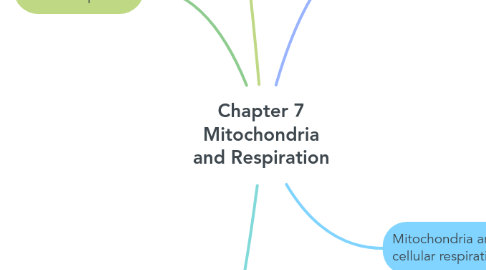
1. Endosymbiont hypothesis
1.1. **Concept:** Mitochondria and chloroplasts evolved from free-living bacteria engulfed by an ancestral eukaryotic cell.
1.2. Evidence
1.2.1. Double membrane structure
1.2.2. Own circular DNA (like bacteria)
1.2.3. 70S ribosomes (similar to bacterial ribosomes)
1.2.4. Reproduction by binary fission (independent division like bacteria)
1.2.5. Sensitivity to antibiotics that target bacteria
1.3. Evolutionary Steps
1.3.1. 1. Ancestral eukaryotic cell engulfed an aerobic bacterium → Became mitochondria.
1.3.2. 2. Some cells later engulfed a photosynthetic bacterium → Became chloroplasts.
2. The function of cellular respiration
2.1. **ATP Production:** Powers cellular activities like movement, active transport, and biosynthesis.
2.2. **Biosynthesis:** Provides building blocks for proteins, nucleotides, and lipids.
2.3. **Heat Generation:** Maintains body temperature in warm-blooded animals.
2.4. **Waste Removal:** Converts glucose into CO₂ and H₂O, which are expelled from the body.
2.5. **Adaptation:** Enables survival in different oxygen conditions (aerobic vs. anaerobic respiration).
3. Material of cellular respiration
3.1. Primary Fuel Sources for Cellular Respiration
3.1.1. Carbohydrates (Primary Energy Source)
3.1.1.1. Glucose (C₆H₁₂O₆) → Most commonly used for ATP production.
3.1.1.2. Other sugars (fructose, galactose) are converted into glucose or glycolysis intermediates.
3.1.1.3. Stored as glycogen in animals and starch in plants.
3.1.2. Fats (Lipids) – High-Energy Storage Molecules
3.1.2.1. Broken down into: Glycerol → Enters glycolysis. Fatty acids → Converted into Acetyl CoA via β-oxidation.
3.1.2.2. Yield more ATP per gram than carbohydrates.
3.1.2.3. Major energy source during fasting or prolonged exercise.
3.1.3. Proteins – Alternative Fuel Source
3.1.3.1. Broken down into amino acids, which are deaminated (removal of NH₃).
3.1.3.2. Remaining carbon skeletons enter Krebs cycle as intermediates.
3.1.3.3. Used mainly when glucose and fats are unavailable (e.g., starvation).
3.2. Electron Carriers
3.2.1. NAD⁺ → NADH and FAD → FADH₂ transport electrons to the ETC.
3.3. Key Intermediates
3.3.1. **Pyruvate:** End product of glycolysis; converted to Acetyl CoA or used in fermentation.
3.3.2. **Acetyl CoA:** Enters the Citric Acid Cycle for further ATP production.
4. Catabolic pathways and production of ATP
4.1. Anaerobic Resppiration
4.1.1. Obligate anaerobes: Can't survive in O2
4.1.2. Falcultative anaerobes: Make ATP by aerobic respiration (with O2 present) or switch to fermentation (no O2 available)
4.1.3. Consumes organic molecules and O2 and yields ATP
5. Mitochondria and cellular respiration
5.1. Four Stages of Respiration
5.1.1. 1. Glycolysis (Cytosol) Glucose → 2 Pyruvate + 2 ATP + 2 NADH
5.1.2. 2. Pyruvate Oxidation (Mitochondria) 2 Pyruvate → 2 Acetyl CoA + 2 NADH + 2 CO₂
5.1.3. 3. Citric Acid Cycle (Krebs Cycle) 2 Acetyl CoA → 2 ATP + 6 NADH + 2 FADH₂ + 4 CO₂
5.1.4. 4. Electron Transport Chain (ETC) & Chemiosmosis NADH & FADH₂ transfer electrons → H⁺ gradient → ATP synthesis
5.2. Structure of Mitochondria
5.2.1. Outer membrane, Inner membrane, Cristae, Matrix
5.2.2. Contains DNA, Ribosomes, Enzymes for ATP synthesis
